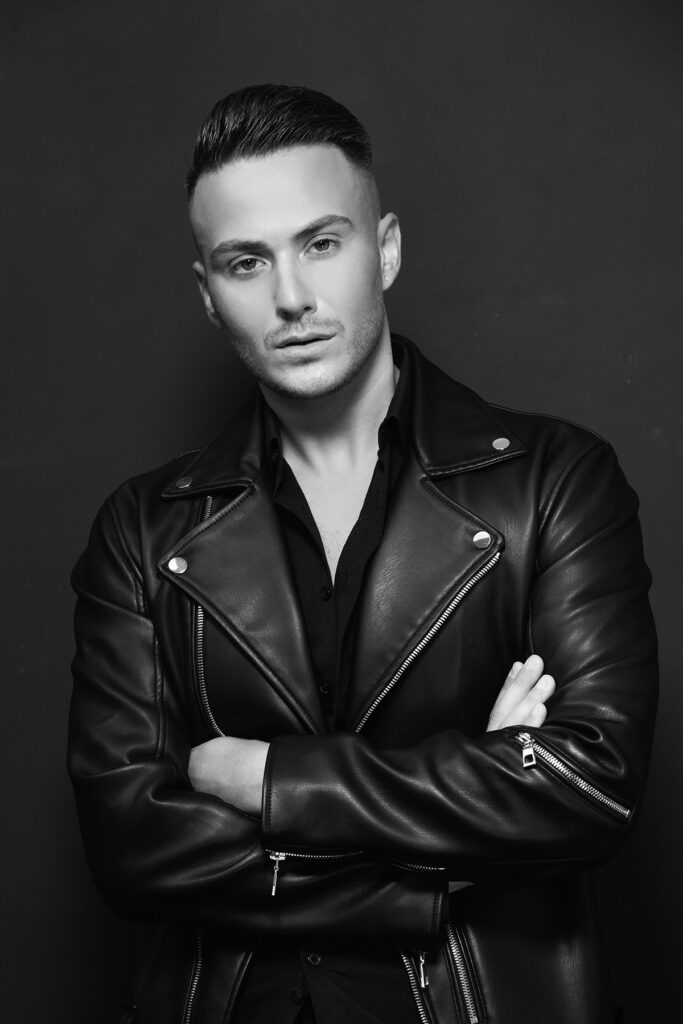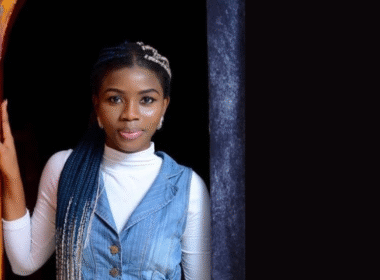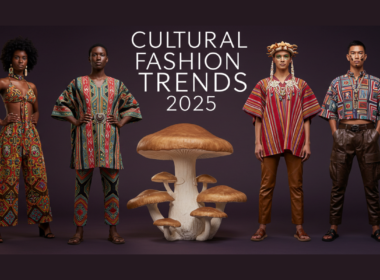Edis Pala’s designs strike a delicate balance between creativity and practicality, with a focus on innovative textiles and unexpected cuts. In this exclusive interview with FAB Magazine, Edis Pala shares insights into his evolution as a designer, the challenges he faced, and the profound influence of his heritage on his creations.
Edis Pala: Everything began before the debut of Bronto in 2016. Step by step, we crafted the story and fostered a community prior to the launch. We orchestrated a bold fashion show at a hotel in Bulgaria, which attracted numerous celebrities.
Reflecting on it now, with all the knowledge I’ve gained, I’m still astonished by how we managed to bring it all together. Despite our lack of experience, the mistakes were apparent. However, you could still discern the essence of the brand’s story and concept. Over the course of three years, driven by my ambition, I identified the hurdles holding me back from advancing in my career. Consequently, I made the decision to move to Milan and pursue studies in fashion design.
Arriving there, I immersed myself in the world of fashion, where myriad cultures and aesthetics converged. It was a fascinating experience, albeit demanding, as Italian education rigorously challenges boundaries. Yet, I found the creation of collections, fashion design classes, and textile courses deeply engaging. Gradually, I excelled, earning top scores and the admiration of my teachers, who recognised my passion and talent. This led to opportunities to collaborate with online magazines, participate in Milan Fashion Week, and work with various brands.
As I delved deeper into the industry, I found myself naturally gravitating towards teaching and sharing my knowledge. Remarkably, I never perceived it as work or study; rather, it felt like a fulfilling endeavour that continuously inspired me. Despite my demanding schedule, I remained energised and driven.
Upon graduation, I faced a pivotal decision: to continue working for established brands or to embark on my own vision. Considering my character and aspirations, I chose the latter. Rejecting the allure of staying abroad, I returned to Bulgaria with a determination to invest in my homeland. My goal is to bolster the economy by producing locally and rekindle my journey on my own terms.
Creativity and Functionality
Edis Pala: It was interesting because it started to be recognized by a group of people from the very beginning. After my second collection, I started dressing a lot of famous singers in Bulgaria, and a lot of people started knowing me. For instance, here it is hard to step in, but when you step in, people see the difference, and they kind of like people who always want to be different—want to be creative in a different way.
When I began directing popular individuals, their support proved invaluable. It was a gradual process, but step by step, we made progress. “But for me, it’s always the message—the strong message—that I’m giving, and people see it through the static. And this has been immensely beneficial for me. However, when it comes to aspects like wholesale and continuous sales, particularly with brands targeting the mass market, it poses challenges due to the relatively small and unrecognised demographic in Bulgaria. I aim to expand this demographic. I believe that venturing beyond Bulgaria with my aesthetic will be more feasible. In fact, I consider it crucial to explore new markets. For instance, there’s a growing interest in my aesthetic among people in Dubai.
Stepping outside one’s own country allows for reaching new audiences and generating buzz around the brand. Remaining confined within one’s own country or bubble can hinder progress. Therefore, I emphasise the importance of venturing into new territories.”
FAB: How do you approach the balance between creativity and functionality when designing your collections?
Edis Pala: For me, it’s really important to have this balance. To maintain practicality, I’m really into the textiles and the prints. I think this is the way I approach my aesthetic. Using a different kind of garment, like a normal garment, and transforming it with asymmetrical hands and different kinds of shapes gives you both practicality and creativity as well.
Cultural Influences and Inspirations
FAB: Are there any designers or artists who have particularly influenced your style or aesthetic?
Edis Pala: Yes, they are, for sure. I think that I can shock you when I tell you that I really like the aesthetic of Armani, who is like the total opposite of my aesthetic.
I always like Vivien Westwood and British designers; I really like them from an artistic point of view. For example, they really influenced me in terms of experimenting with textures, abstract drawings, and interpretations of history. And when we talk about elegance, I like to have this kind of elegant approach. Italy really helped me in terms of Italian designers. For example, when people sometimes ask me, I really like the Versace girl, the aesthetic of Versace, and also Armani. In terms of the Italian approach, I kind of see myself in the balance between those two opposites. Again, two completely different designers.
When we talk about creativity, I’m really inspired by John Galliano, Alexander McQueen, and Vieviene Westwood. I think that, as designers, British and Italian designers really inspire me.
Edis Pala on Overcoming Challenges as a Creative
FAB: What challenges have you faced in your career as a designer, and how have you overcome them?
Edis Pala: In the beginning, it was really hard because no one knew about me, and unfortunately, in Bulgaria, there’s not a huge history in fashion, and people are not well-educated about fashion and designer items. From this perspective, it was initially challenging for me to assemble a team and get assistance in creating everything for the collection. And I’m not just referring to the garments themselves; I’m also talking about photo shoots, social media content, and so on. This has been an ongoing struggle for me.
For instance, it’s now quite easy to collaborate with Elise and organise events in Paris, thanks to you and many others. I know you have knowledge and understanding of the fashion industry. When I mention a term or concept, you immediately grasp what I’m referring to. However, here in Bulgaria, it’s still quite challenging from this standpoint. I’m constantly battling with it. People here simply don’t understand that when you’re a creative director and you have a vision, you must adhere to that concept. It’s difficult because I’m deeply invested in what I want. It becomes even more challenging when, for example, the photographer presents a viewpoint that doesn’t align with mine. These struggles have persisted from the beginning up until now.
FAB: How do you stay inspired and motivated to continue innovating in an industry that is constantly evolving?
Edis Pala: It’s really hard because I’ve been struggling so many times during all these years. And sometimes the best question that really motivates me is when I ask myself, OK, if I look around, if I stop doing what I’m doing, can I survive emotionally? And the answer is, No, I can’t.
Basically, if I don’t design, I don’t know, and I don’t think I will be able to live for sure.
FAB: Can you tell us about the inspiration behind the “Infinity Fusion” Fall/Winter 2024 Collection? The concept of Yin and Yang is mentioned as connecting to the brand’s aesthetic and philosophy. How is this concept reflected in the designs and overall ethos of the “Infinity Fusion” collection?
Edis Pala: When conceptualising this collection, the significance of the number eight caught my attention, as the brand is marking its eighth year. Personally, I’m deeply influenced by the philosophy of Yin and Yang, symbolizing the harmony of opposing forces that complement each other, much like the duality inherent in everything. Concepts like light and dark and black and white resonate strongly with me, representing different facets of my perspective.
Considering the number eight, it can be perceived as an hourglass, symbolising the passage of time, or when turned, it transforms into the infinity symbol, representing boundlessness. This duality inspired me to create designs that embody freedom, with never-ending lines in the prints, connecting the sky with earthly textures. I aimed for individuals to experience a sense of liberation when engaging with the collection, exploring various perspectives of the world.
Each collection I create tells a unique story, and with this one, I wanted to infuse elements of Albanian culture alongside the broader themes. Ultimately, my goal is to empower people to believe in themselves, recognising their importance in their own success—it’s about them, their journey, and their potential.
It’s everything about them. But in this collection, you also have something about Albanian culture.
FAB: Your collection features unconventional cuts and unexpected details. Can you walk us through some of the design choices made to achieve this?
Edis Pala: The cuts are really important for me because, when you create a textile or a collection, the dynamic is really important. As you can see, like the collection, it’s always going from like, it’s giving you the whole vibe as one collection, but it’s always something unexpected.
And, because I’m the designer who really draws, I hand draw on paper and then make it transparent in Photoshop. When I design it, for example, I am quite abstract. When I pursue one concept, it invariably leads to the development of new ideas.
You can transform the textile not only through painting but also through cuts. And for example, if you have one dynamic as an all-over print, when you combine a different cut, a different kind of asymmetrical hem, or something else, you can do a bit of destruction to this print. It’s the same print, but you destroy it in a different way.
For instance, when crafting a collection, I conceive it like a box containing various elements—perhaps three distinct prints or a unique trouser design. These elements serve as inspiration, which I then reimagine and reinterpret to align with the overall collection aesthetic. It’s about infusing different aesthetics into a cohesive vision, allowing for creative development without overwhelming with excessive details. The focus is on precision and the art of transformation within the conceptual framework.
FAB: How does traditional Albanian culture influence the designs in this collection, particularly the homage paid to traditional trousers?
Edis Pala: I’m quite mixed. I hail from the Balkan countries, so all of my grandparents come from different nations. Thus, I have Albanian, Serbian, Turkish, and Bulgarian heritage in my blood.
Regarding culture, when I was a child and during my early university years, I initially dismissed brands that focused on folklore and traditional costumes as ugly and unattractive. However, as I grew older, I began to appreciate the intricacies of pattern making and the unique shapes inherent in these designs. They became a significant source of inspiration for me. For instance, I’ve been wearing Albanian traditional trousers for many years now. I’ve noticed numerous collections featuring variations of these trousers, and even after eight years, I still find them appealing. What’s more, my customers and those who appreciate my work continue to buy them. These garments hold deep cultural significance for me, as they reflect the heritage of my upbringing.
I believe they add an edgy vibe to my style, which is something I’ve always gravitated towards. It’s remarkable to think that I can blend the diverse cultures of the countries I come from into one cohesive aesthetic.
FAB: The colour palette for this collection is described as dark, cold, and bold, with a hint of chartreuse. What significance does this palette hold within the context of the collection’s theme?
Edis Pala: I’m particularly drawn to cool and vibrant colours. However, it’s quite challenging for me to incorporate softer, pinkish hues or Rococo-inspired colours into my designs. These colours, while sweet, don’t align with my aesthetic, which revolves around boldness and breaking barriers. When developing a colour palette, I often draw inspiration from historical pictures rather than contemporary fashion images.
I delve into old, war-era photographs depicting ordinary workers and historical scenes. Analysing black-and-white photography helps me understand the nuances of colours, from shades of grey to more subdued tones. Introducing a pop of colour is essential to injecting dynamism into the collection.
For instance, I use a yellow-green hue to create balance, strategically placing it throughout the designs. Dark blue is another favourite of mine—it’s versatile and elegant, allowing for both extraordinary and refined creations. This colour palette reflects not only my design preferences but also complements various personalities and styles.
FAB: What advice would you give to aspiring designers who are just starting their journey in the fashion world?
Edis Pala: For sure, I’m going to tell them that the journey is not going to be easy. Don’t expect to achieve great success after the first year; it’s a continuous process of improvement. Sometimes, it may take 20 years to reach your biggest success, but even then, you shouldn’t stop. You need to understand yourself, ask yourself numerous questions, observe people, understand who your designs are for, and how they interact with the world.
Observe their activities, where they go, what clubs they frequent, and where they eat lunch in order to understand your customer and draw inspiration from them. To develop your aesthetic, you may not know everything you know now, but it’s crucial to understand the message you want to convey, your objectives, and how to transform your worldview into an aesthetic.
This process can be aided by various sources, such as movies, history, books, and interviews from the past. Learning about fashion history, such as the changes in fashion throughout the 20th century, and identifying with different decades can greatly inform your aesthetic choices. For instance, you might be drawn to the pockets of the 1940s or the colours of the 1980s.
Combining these elements that resonate with you can help you tell a complete story through your designs. Focus on refining your aesthetic, harnessing your imagination, and organising your creativity. Creative designers often have numerous ideas, and it’s essential to know how to channel and structure them effectively.
Moreover, don’t let negative feedback deter you. Instead, let it motivate you to prove them wrong. Believe in yourself and keep pushing forward despite any obstacles. I’ve personally faced discouragement from many people who doubted my abilities, but I didn’t let it stop me. I continued to pursue my dreams.
FAB: Lastly, what legacy do you hope to leave through your work as a fashion designer?
Edis Pala: Oh, that’s a really insightful question. I’m someone who constantly reflects on these matters. I genuinely hope, pray, and manifest every day that I’ll be counted among the designers who convey a powerful message. Perhaps the message I aim to convey is centred around the idea that it’s all about self-discovery. Stay up to date on the newest in the world of Fashion, Arts, Beauty and Lifestyle; Follow FAB on Instagram.
I want people to see me not just as a designer but as someone who empowers them to become better individuals and to pursue their dreams. That’s the message I strive to deliver. Of course, my bold aesthetic and aggressive approach to fashion will always be present, but I want the focus to be less on the collection itself—its garments, textures, and innovations, although those will naturally evolve over time—and more on people recognising me as Edis Pala, the brand that instigated change.”

Fun Zone: #FabFast5
- FAB: Sewing or painting?
Edis Pala: Painting - FAB: The best colour in the rainbow?
Edis Pala: The shade between blue and purple. - FAB: Milan or Paris?
Edis Pala: Tough one; let’s say Paris for now. - FAB: Your always on repeat music?
Edis Pala: Dua Lipa Houdini - FAB: What is your favourite food?
Edis Pala: French fries.
More Like This:
Is It Time To End Beauty Misconceptions?
In Search of Home in Music: Barbara Alli Weaves Fashion, Culture, and Music


















